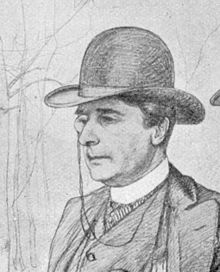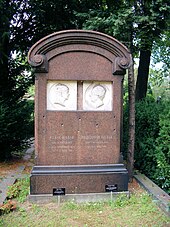Friedrich Haase (actor)

Friedrich Ludwig Heinrich Haase (born November 1, 1825 in Berlin ; † March 17, 1911 there ) was a German theater actor , director and director . Since 1878 he was the fourth holder of the Iffland-Ring .
Life
His father was Friedrich Wilhelm IV's first valet , and as the king's godchild, he enjoyed a very careful upbringing. The king recommended the young man who was striving for the stage to Ludwig Tieck , and Haase put his first talent test in Tieck's salon by declaiming Goethe's Erlkönig . After two years of training under Tieck's direction, he received his first engagement from June 14, 1846 to 1847 in Weimar . He made his debut on the first evening in Der arme Poet and Der Hofmeister in a thousand fears . Then he went to Potsdam (1848–1849).
After a guest performance (requested by the King) in Berlin in 1849 (then director: Karl Theodor von Küstner ) in the plays The Tide Has Turned (“Amtsrath Poll”), Kabale und Liebe (“Wurm”), Dr. Wasp ("Adam") and The gallant Abbé ("Claudius") he received an engagement in Prague (March 1850 to April 1852), then moved to Eduard Devrient in Karlsruhe (1852-1853), to Franz von Dingelstedt (1853 ) in Munich –1855), to Frankfurt am Main (1856–1858), to Petersburg (1860–1864) and then headed the court theater in Coburg (1867–1868).
From 1869 to 1870 he was at the Royal Theater in Berlin , after which he worked again as a theater director in Leipzig (1870–1876). After that he only worked as a guest again.
In March 1869 he made a guest appearance in the USA in New York and again from October 1881 to May 1882 he played on all North American concerts for a hundred evenings.
From autumn 1883 to spring 1884 he was a partner in the founding of the Deutsches Theater in Schumannstrasse in Berlin.
In 1878 he was made an honorary member of the Royal Court Theater by King Albert, with the obligation to pray ten evenings each year for a fixed fee. In the same year he also became an honorary member of the Schiller Club.
Altogether he played as a guest on 95 German-speaking stages (Germany 68, Austria 7, Holland 2, Russia 4, Switzerland 4 and USA 10). He was awarded medals by almost all German monarchs. He had three Komturen first and second order, seven Knights crosses the first division, five gold medals for Kun and Science and "The merit" etc. Friedrich Haase was from 1878 until his death in the fourth winner of the Iffland-Ring . The myth about the ring goes back in part to him.
Haase was married twice. In 1858 he married the opera singer Elise Capitain , but this marriage was soon separated. His second wife was the actress Elise Schönhoff (1838–1911).
Haasestrasse in Berlin-Friedrichshain , which connects Revaler Strasse and Simplonstrasse , is named after him.
Death and grave

Despite various ailments, he was still very vigorous into old age, and after a brief illness, Friedrich Haase died on March 17, 1911 at the age of 85 in Berlin. A few months after an operation, a fever had suddenly set in, which debilitated him, which led to death within a week. The funeral, attended by Rudolf Mosse and Georg von Hülsen-Haeseler , among others , took place on March 21 at Cemetery III of the Jerusalem and New Churches in front of the Hallesches Tor . At the funeral service, chaired by Theodor Krummacher , Max Grube paid tribute to the deceased's merits "in a sparkling, enthusiastic speech". The widow Elise Haase b. Schönhoff, suffering from a heart condition for a long time, died only four weeks later and was buried on Easter Monday, April 17, 1911, at the side of her husband.
The Haase grave monument is a high stele made of red granite with a round arch. At the front there are two “excellently crafted” marble reliefs that show the couple in profile and facing each other. The portrait of Friedrich Haase is by Rudolf Dietelbach , the Elise Haase by Richard Anders . The grave monument was restored in the 1980s.
Portrait medal
- 1905, bronze medal, 55 mm, medalist: Max Klein . Front: head portrait to the left, without writing. Back: Between two laurel branches crossed below, 6 lines of text: DEM / ALTMEISTER / FRIEDRICH HAASE / ON THE 80th BIRTHDAY / NOV. 1905 / HIS ART COMPANIES. Literature: Marienburg Collection No. 10760.
Works
- Bare letters. Heinrich Minden, Dresden / Leipzig 1883.
- What I experienced 1846–1896. Bong, Berlin 1897.
literature
- Robert Heller: A virtuoso of the stage world . In: The Gazebo . Issue 13, 1866, pp. 203–205 ( full text [ Wikisource ]). With illustration by Herbert König .
- Adolph Kohut : The Dresden Court Theater in the Present . E. Pierson's Verlag, Dresden / Leipzig 1888, p. 143 f., Textarchiv - Internet Archive .
- Ludwig Eisenberg : Friedrich Haase . In: Large biographical lexicon of the German stage in the XIX. Century. Paul List, Leipzig 1903, p. 376 ( daten.digitale-sammlungen.de ).
- Paul von Ebart: Friedrich Haase as director of the Koburg-Gothaischen Hoftheater. In: German Review. March 1912 (with excerpts from Haase's correspondence).
- Hans Knudsen : Haase, Ludwig Heinrich Friedrich. In: New German Biography (NDB). Volume 7, Duncker & Humblot, Berlin 1966, ISBN 3-428-00188-5 , p. 380 ( digitized version ).
Web links
Individual evidence
- ^ Helene Tank-Mirow: History of the Schwerin Court Theater 1855–1882. ( Memento of the original from May 16, 2010 in the Internet Archive ) Info: The archive link was inserted automatically and has not yet been checked. Please check the original and archive link according to the instructions and then remove this notice. In: Yearbooks of the Association for Mecklenburg History and Archeology. Volume 88, 1924, pp. 59-107.
- ↑ Haasestrasse. In: Street name lexicon of the Luisenstädtischer Bildungsverein (near Kaupert )
- ^ Fritz Engel: Friedrich Haase † . In: Berliner Tageblatt , March 17, 1911, evening edition, pp. 1–3.
- ↑ Friedrich Haase's funeral . In: Berliner Volks-Zeitung , March 22, 1901, morning edition, first supplement, p. 1.
- ↑ Friedrich Haase's widow died . In: Berliner Volks-Zeitung , April 15, 1911, evening edition, p. 2.
- ^ Cemetery III of the Jerusalem and New Churches . Description of the cemetery in the monument database of the Landesdenkmalamt Berlin (accessed on March 29, 2019).
- ^ Hans-Jürgen Mende : Lexicon of Berlin burial places . Pharus-Plan, Berlin 2018, ISBN 978-3-86514-206-1 , p. 242.
- ^ Cemetery III of the Jerusalem and New Church Congregation . Information about the burial site on the website of the "Foundation for Historical Churchyards and Cemeteries in Berlin-Brandenburg" (accessed March 29, 2019).
| personal data | |
|---|---|
| SURNAME | Haase, Friedrich |
| ALTERNATIVE NAMES | Haase, Friedrich Ludwig Heinrich |
| BRIEF DESCRIPTION | German theater actor, director and director |
| DATE OF BIRTH | November 1, 1825 |
| PLACE OF BIRTH | Berlin |
| DATE OF DEATH | March 17, 1911 |
| Place of death | Berlin |
